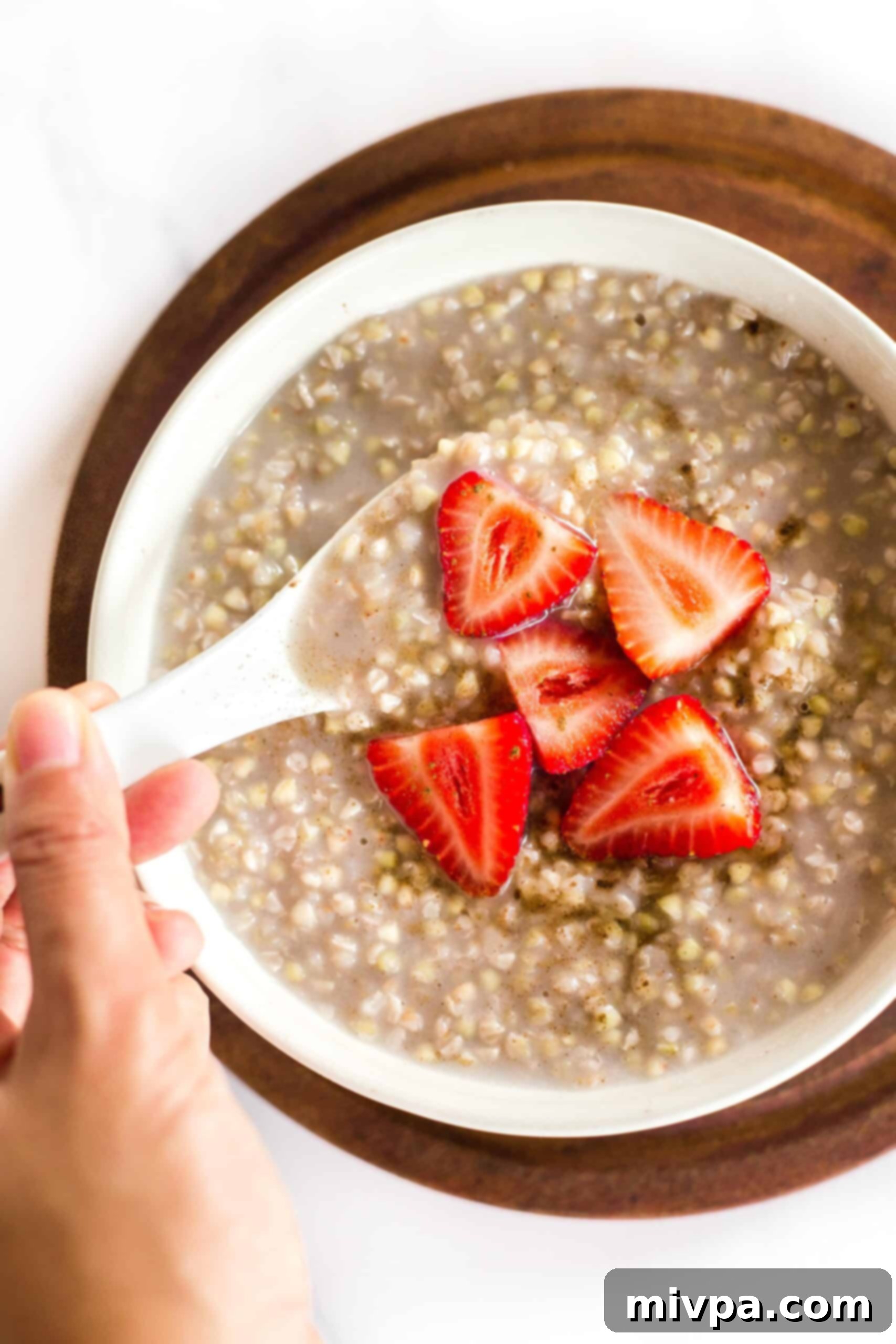Easy Buckwheat Porridge: Your Go-To Gluten-Free, Vegan Breakfast & Healthy Meal!
Imagine starting your day with a breakfast that’s not only incredibly delicious and satisfying but also aligns perfectly with a healthy, plant-based lifestyle. This easy buckwheat porridge offers a wonderfully creamy texture and a hearty, nutty flavor that makes it a fantastic alternative to traditional oatmeal. What’s even better? It’s completely gluten-free, dairy-free, and vegan, making it accessible and enjoyable for a wide range of dietary needs. This healthy porridge comes together in under 15 minutes, making it an ideal choice for a quick yet nourishing breakfast or a wholesome snack any time of day. We highly recommend serving it warm, topped with a vibrant array of fresh fruit, a generous drizzle of pure maple syrup, and a comforting sprinkle of ground cinnamon for an elevated flavor experience.
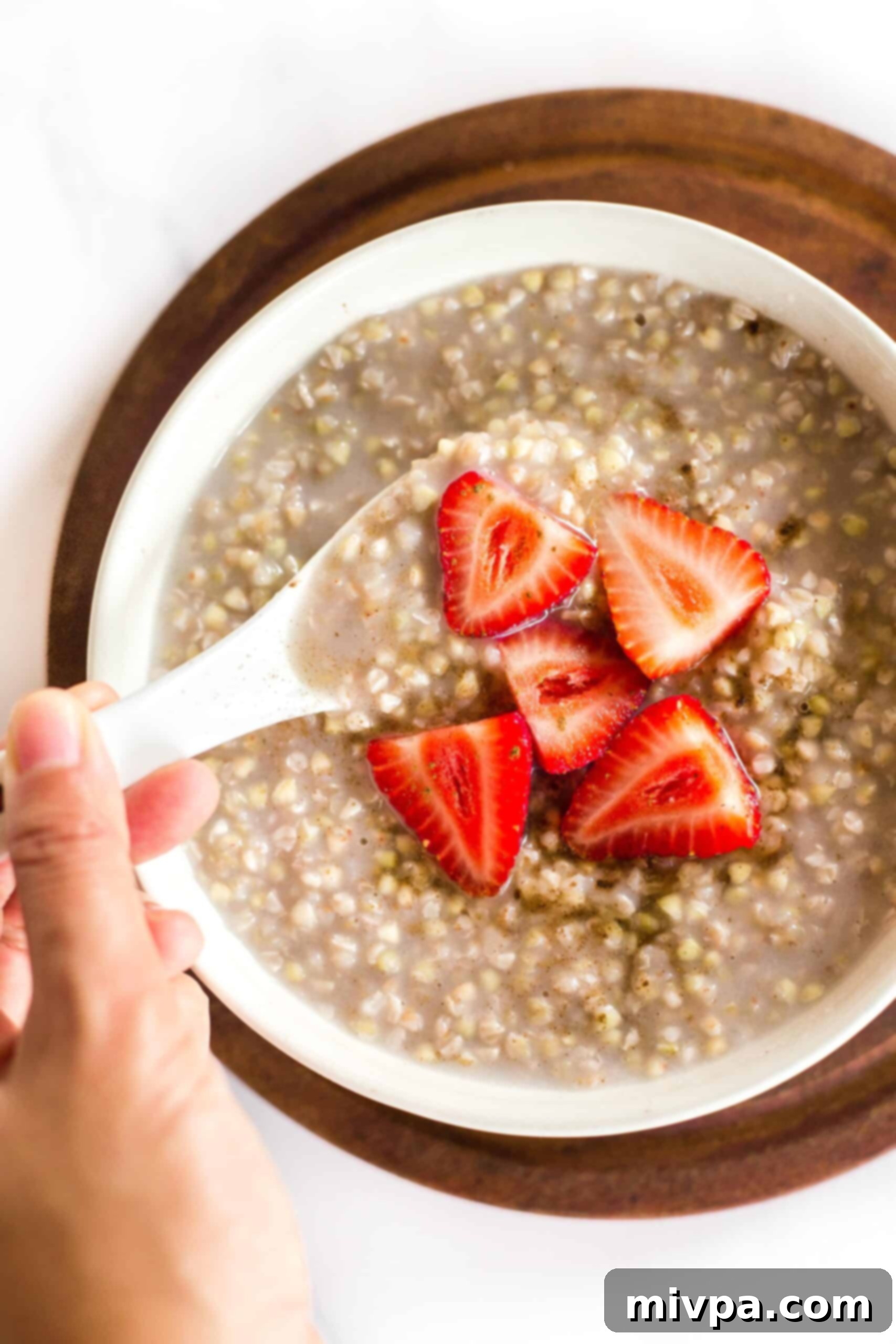
[feast_advanced_jump_to]
What is Buckwheat? Unpacking This Versatile Pseudocereal
Often mistaken for a grain due to its culinary uses, buckwheat is actually a fruit seed, botanically related to rhubarb and sorrel. It’s classified as a “pseudocereal” because, much like quinoa and amaranth, its seeds are consumed and prepared similarly to cereal grains. These distinctive triangular seeds are harvested from the buckwheat plant (Fagopyrum esculentum) and prized for their nutritional density and remarkable versatility in the kitchen. Unlike true grains, buckwheat does not grow on grasses.
Buckwheat offers a wonderfully earthy and nutty flavor profile, which can range from subtle to quite pronounced depending on whether you’re using raw (lightly colored) or roasted (darker, also known as kasha) groats. This unique taste adds a remarkable depth to any dish it’s incorporated into, from savory pilafs and soups to sweet breakfast porridges and baked goods. Beyond its flavor, buckwheat is a powerhouse of nutrition, packed with essential minerals like magnesium, manganese, and copper, a good source of antioxidants (such as rutin), and rich in dietary fiber. This makes it a valuable addition to a balanced and health-conscious diet, promoting heart health, blood sugar control, and digestive wellness.
Is Buckwheat Gluten-Free? Addressing a Common Misconception
The name “buckwheat” can be quite misleading, often leading to the misconception that it contains gluten due to the “wheat” suffix. However, it’s crucial to understand that buckwheat is not related to wheat in any way. It’s not a member of the grass family (Poaceae) that includes wheat, barley, and rye, which are the primary sources of gluten. In reality, buckwheat is inherently and entirely gluten-free. This natural characteristic makes it an exceptional and safe choice for individuals managing Celiac disease, gluten sensitivities, or those simply adhering to a gluten-free diet. Its natural absence of gluten means you can enjoy its many benefits and delicious flavor without any concerns about cross-contamination or adverse reactions often associated with gluten-containing grains. It’s a culinary blessing for anyone seeking nutritious, safe, and diverse gluten-free options, offering peace of mind along with its delightful taste and texture.

A Perfect Alternative to Oatmeal for a Hearty Start
Porridge holds a special place in my heart, evoking warm childhood memories of my dad kickstarting his mornings with a substantial bowl of oatmeal. This tradition instilled in me a deep appreciation for the comforting simplicity of porridge, transforming it into my ultimate comfort food. Over the years, I’ve loved exploring a myriad of grain and seed-based alternatives to oatmeal, pushing the boundaries of what a morning bowl can be. From the nutty richness of flaxseed porridge, offering an omega-3 boost, to the delicate texture of millet porridge, and the complete protein power of quinoa porridge, each exploration has brought new flavors and textures to the breakfast table.
Today, I’m thrilled to introduce you to this exceptionally creamy and satisfying buckwheat porridge, crafted from wholesome buckwheat groats. Its unique texture and robust, earthy flavor make it an absolutely perfect choice for greeting any crisp morning, offering a delightful change of pace from your usual routine. It’s not just an alternative; it’s an upgrade for those seeking more diverse nutrients and a distinct culinary experience in their breakfast bowl. Move over, oats – buckwheat is here to claim its spot as your new favorite morning meal!
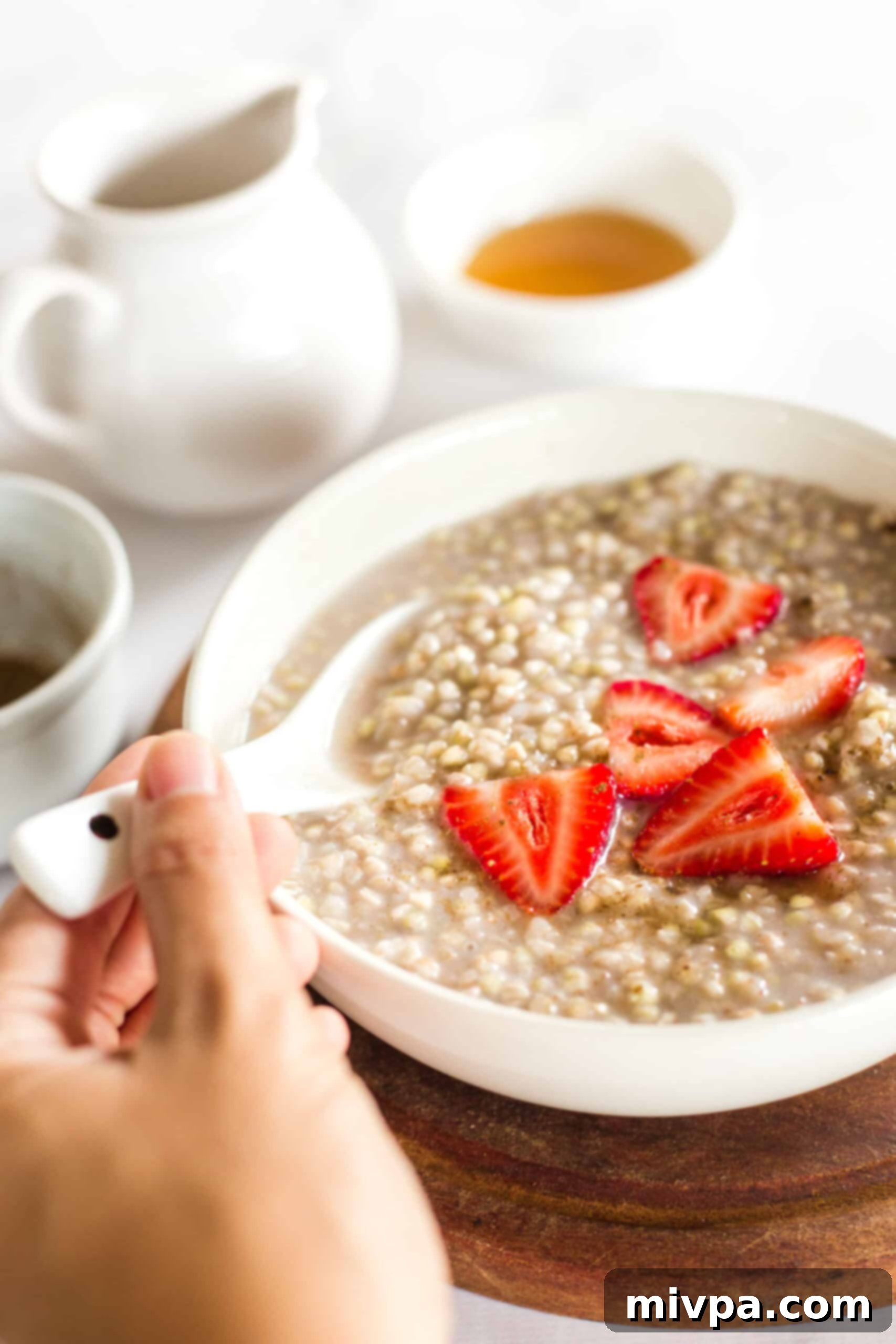
Why This Easy Buckwheat Porridge Recipe is a Must-Try:
- Minimal Ingredients, Maximum Flavor: You’ll be delighted by how few simple ingredients are needed to create this incredibly hearty and flavorful buckwheat porridge. Chances are, many of these kitchen staples are already in your pantry, and the rest are readily available at any local grocery store or natural foods market. This means less shopping, more cooking, and pure, wholesome goodness packed into every spoonful. It’s proof that delicious and healthy doesn’t have to be complicated!
- Effortlessly Easy & Quick: Forget lengthy cooking times! This gluten-free recipe is designed for efficiency, coming together beautifully in under 15 minutes from start to finish. The process is remarkably straightforward: simply combine your chosen ingredients, give them a good stir, and allow them to gently simmer over low heat. Before you know it, you’ll have a wonderfully creamy and perfectly cooked porridge ready to savor. It’s the ideal solution for busy mornings or when you crave a quick, nourishing meal without fuss.
- Incredibly Versatile & Customizable: While this recipe presents a delicately sweetened porridge perfect for a comforting breakfast, its flexibility is one of its greatest assets. You can effortlessly transform it into a savory sensation by simply omitting the maple syrup and cinnamon. Instead, consider adding a splash of gluten-free tamari sauce or coconut aminos, a hint of fragrant sesame oil, and a pinch of salt and black pepper. Garnish with fresh herbs, chopped scallions, or sautéed vegetables for a truly unique and satisfying savory meal that’s perfect any time of day.
- Dietary-Friendly for Everyone: This is truly the best part about this recipe! Our easy buckwheat porridge is meticulously crafted to be 100% gluten-free, completely dairy-free, and entirely vegan. This comprehensive approach ensures that individuals with Celiac disease, gluten intolerances, lactose sensitivities, or those following a plant-based lifestyle can indulge in this wholesome and delicious breakfast without any dietary concerns or compromises. It’s a recipe designed with inclusivity and health in mind, ensuring everyone can enjoy a hearty and flavorful start to their day.
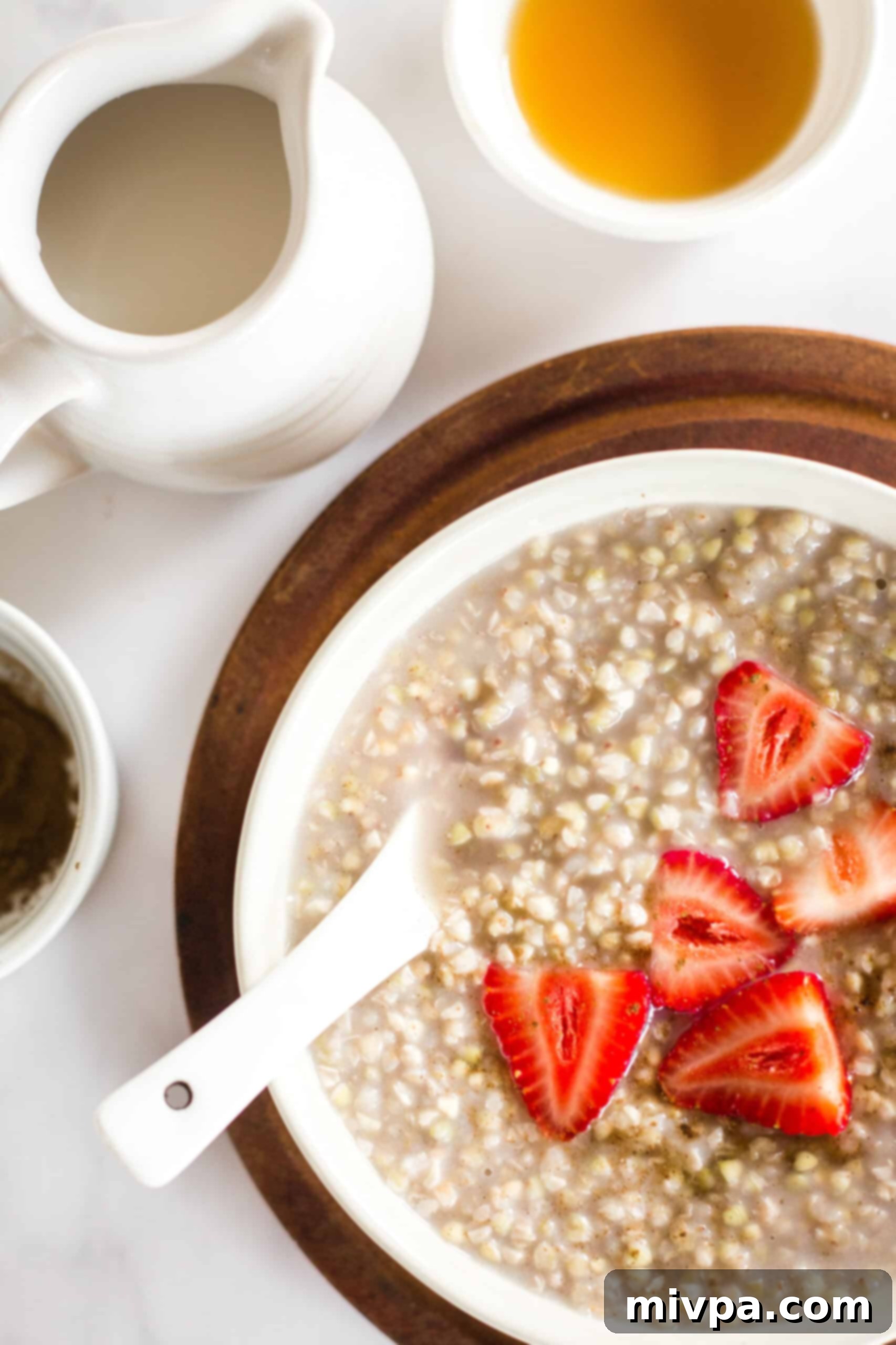
Essential Ingredients You’ll Need for This Recipe:
To bring this delightful gluten-free buckwheat porridge to life, you’ll need a selection of wholesome ingredients. Below, you’ll find a visual overview to help you gather everything you need. For precise measurements and quantities, please refer to the detailed recipe card conveniently located at the very bottom of this post.
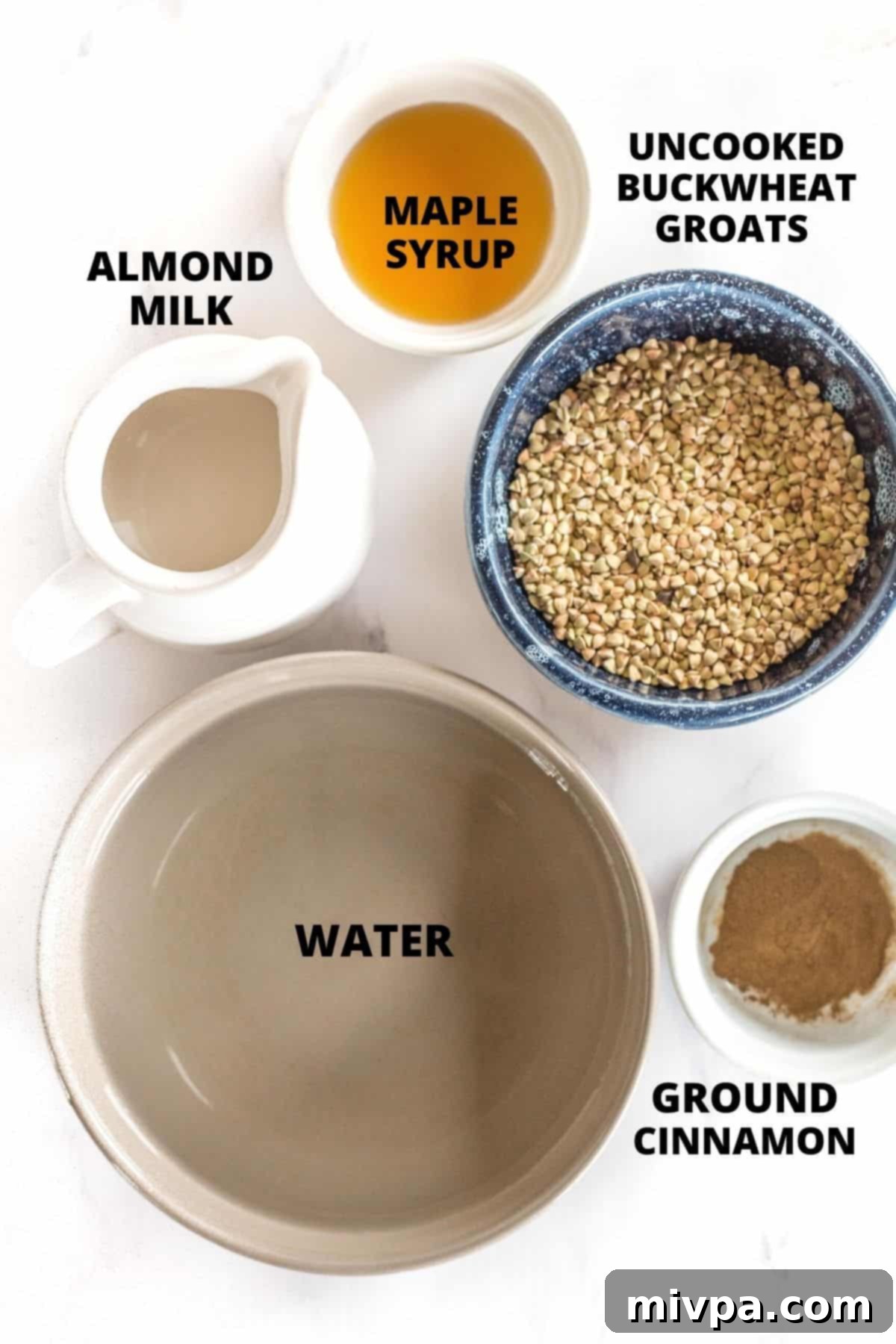
Ingredient Notes and Creative Substitutions:
- Raw Buckwheat Groats: The star of our show! Buckwheat groats are the hulled seeds of the buckwheat plant, and they are absolutely essential for achieving the correct creamy texture and delightful nutty flavor in this porridge. Ensure you’re using raw (unroasted) groats for a lighter color and milder flavor profile in your porridge. Roasted groats, also widely known as kasha, have a much stronger, toastier flavor and a browner color, which would significantly alter the final dish’s taste and appearance.
- Filtered Water: While plain potable tap water or mineral water can certainly be used, I highly recommend using filtered water. This small step can make a noticeable difference in the overall purity of flavor of your porridge, ensuring no unwanted tastes or impurities interfere with the delicate notes of buckwheat and other ingredients.
- Unsweetened Almond Milk (or other Non-Dairy Milk): For a truly creamy and luxurious texture, unsweetened almond milk is my preferred choice. My 5-minute homemade almond milk works wonders, but feel free to experiment with other non-dairy alternatives that you enjoy and fit your dietary preferences. Excellent options include homemade cashew milk, creamy rice milk, rich soy milk, velvety coconut milk (ensure it’s from a carton, not canned, for this recipe’s consistency), or even sunflower seed milk for a nut-free option. Alternatively, if dairy is not a concern for your diet and you’re not strictly vegan, regular dairy milk can also be used as a simple substitute.
- Pure Maple Syrup: This natural sweetener adds a delightful, subtle sweetness to the porridge without overpowering the buckwheat’s inherent nutty taste. Pure maple syrup is also a fantastic vegan choice, providing a rich, earthy sweetness. As an alternative, agave nectar can be used for a similar sweetness profile. For those who are not following a strict vegan diet, a touch of raw honey can also provide a wonderful depth of sweetness and flavor. Always adjust the amount of sweetener to your personal preference.
- Ground Cinnamon: A pinch of aromatic ground cinnamon elevates the flavor profile of this porridge, adding a warm, comforting, and inviting spice. If you don’t have ground cinnamon, a small cinnamon stick can be simmered with the groats and then removed before serving. If cinnamon isn’t your favorite spice, or if you’re looking for a different flavor, feel free to omit it entirely. Alternatively, a tiny sprinkle of cacao powder can introduce a subtle chocolatey note, or a pinch of ground cardamom could offer an exotic and fragrant twist to your breakfast.
How to Make Creamy Buckwheat Porridge (Step-by-Step Guide)
1. Combine Buckwheat Groats and Water
In a small pot or small saucepan, meticulously combine the uncooked buckwheat groats and filtered water. Bring this mixture to a rolling boil over medium-high heat, ensuring the groats are fully submerged in the liquid. This initial boil is crucial for softening the groats and kickstarting the cooking process.
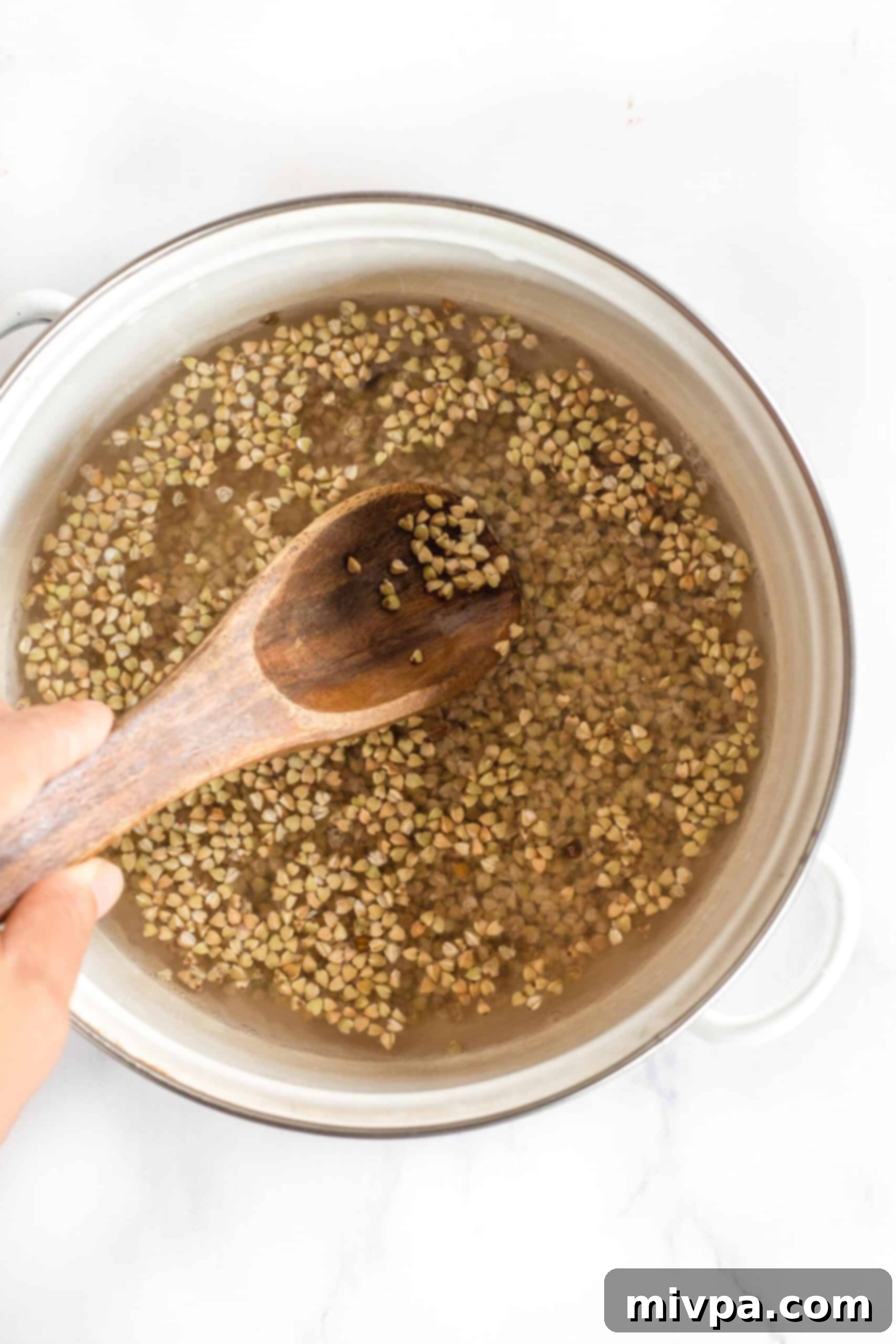
2. Reduce Heat and Simmer
Once the mixture reaches a vigorous boil, immediately reduce the heat to its lowest setting. Cover the pot tightly with a lid, allowing the ingredients to gently simmer for approximately 10 to 12 minutes. Stir occasionally to prevent sticking to the bottom of the pot and to ensure even cooking and absorption of the liquid. During this simmering time, the buckwheat groats will absorb the water, soften considerably, and begin to develop a creamy, thick consistency, much like traditional oatmeal.

3. Serve and Enjoy
Once your creamy buckwheat porridge has reached the desired consistency – tender, yet with a slight pleasant chew – remove it from the heat. Divide the warm porridge evenly between two serving bowls. Enhance each portion with a generous splash of your preferred unsweetened milk (dairy or non-dairy) to achieve ultimate creaminess, and then get creative with your toppings! Garnish generously with an assortment of fresh fruit like berries or sliced bananas, a luscious drizzle of pure maple syrup for added sweetness, and a final comforting sprinkle of ground cinnamon. Serve immediately and savor every wholesome, nutritious spoonful.
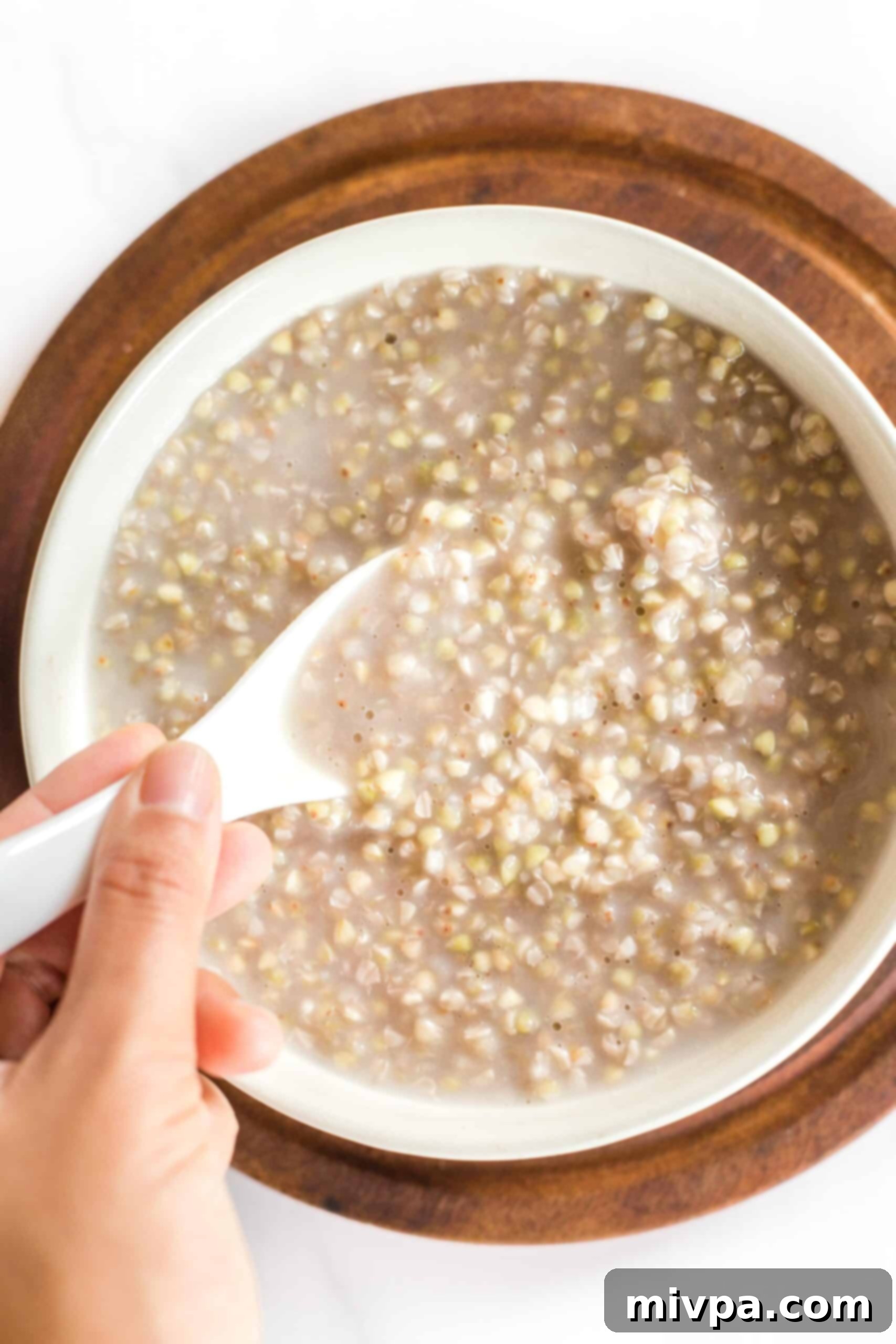
Dish by Dish Tips & Tricks for the Perfect Buckwheat Porridge:
- Elevate with Optional Toppings: While simple is undeniably delicious, a wide variety of toppings can transform your buckwheat porridge into a gourmet experience. Beyond fresh fruit, consider adding a sprinkle of nutrient-rich chia seeds or ground flaxseed for an omega-3 boost, crunchy chopped nuts (like walnuts, pecans, or almonds) for texture, or decadent cacao nibs for a subtle chocolatey crunch. A splash of vanilla extract can enhance the sweetness and aroma, or for an extra layer of richness, swirl in a spoonful of creamy almond butter, peanut butter, or cashew butter into your delicious breakfast bowl. Don’t be afraid to mix and match to find your perfect combination!
- Enjoy Warm or Cold: This porridge is incredibly versatile when it comes to serving temperature, making it suitable for any season. On a brisk morning, there’s nothing quite like a steaming bowl of warm buckwheat porridge to comfort and energize you from the inside out. However, don’t underestimate its appeal as a chilled treat! Prepare a batch, let it cool completely, and store it in the fridge for a refreshing breakfast or snack on warmer summer days. It’s equally delicious served cold, often taking on a slightly firmer, pudding-like consistency that’s wonderfully satisfying.
- Craft a Savory Masterpiece: While our base recipe leans sweet, buckwheat porridge is wonderfully adaptable for savory preparations, offering a unique and satisfying alternative to sweet breakfasts. To create a savory porridge, simply omit the maple syrup and cinnamon from the cooking process. Instead, stir in a dash of tamari sauce (for a gluten-free soy sauce alternative) or coconut aminos for umami depth, a drizzle of fragrant sesame oil, and a generous pinch of salt and freshly ground black pepper. Top with chopped scallions, toasted sesame seeds, sautéed mushrooms, a sprinkle of nutritional yeast for a cheesy flavor, or even a fried egg (if not strictly vegan) for a truly satisfying and unique savory meal.
- Meal Prep with a Big Batch: Streamline your healthy eating routine by preparing a larger batch of this delicious and hearty buckwheat porridge. Simply double or even triple the recipe as needed. Once cooked and cooled completely, transfer the porridge to an airtight container and store it in the refrigerator for up to 3-4 days. This makes for incredibly convenient grab-and-go breakfasts or quick, wholesome snacks throughout the busy week. To reheat, gently warm it on the stovetop with a splash of extra milk or water to restore its creamy texture, or microwave it until heated through.
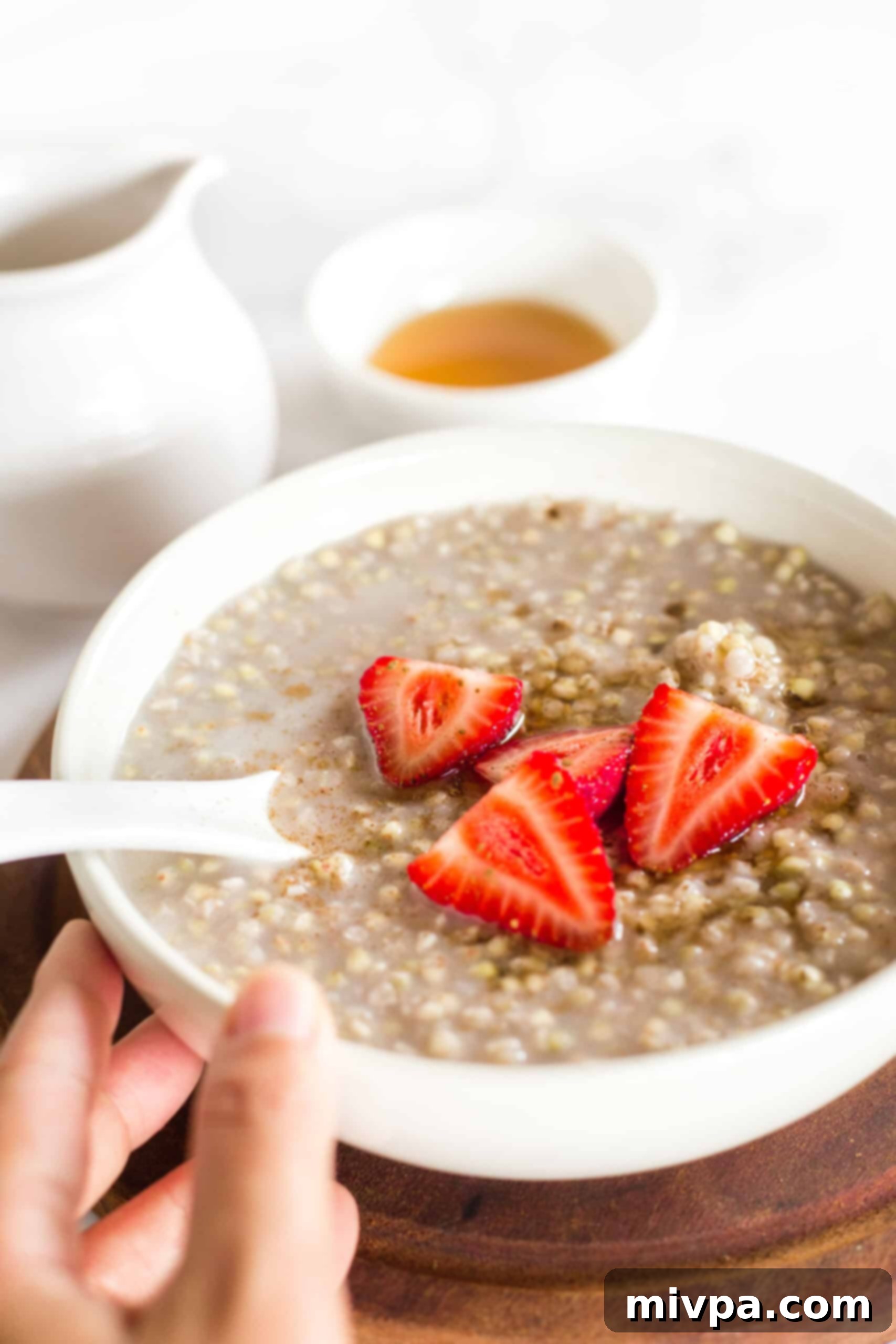
Frequently Asked Questions About Buckwheat Porridge:
Yes, absolutely! Despite its name, buckwheat is not related to wheat and is naturally gluten-free. It’s a pseudocereal, a fruit seed, and is perfectly safe for those with Celiac disease, gluten allergies, or intolerances to enjoy without any concerns. Always ensure you purchase buckwheat groats that are certified gluten-free if cross-contamination is a major concern.
Once cooled, transfer any leftover buckwheat porridge to an airtight container and refrigerate it for up to 3-4 days. For reheating, simply warm it gently in a small pot on the stovetop with a splash of extra milk (dairy or non-dairy) or water to restore its creamy consistency, stirring frequently, or microwave it in short intervals until heated through.
Buckwheat porridge, when cooked correctly with raw groats, has a wonderfully creamy and slightly chewy texture, similar to a heartier oatmeal but often with more individual grain definition. It’s less gooey than some oat porridges and offers a pleasant mouthfeel with a subtle bite. The consistency can be easily adjusted by adding more or less liquid during or after cooking to suit your preference.
Yes, absolutely! Buckwheat porridge is an excellent option for meal prepping. You can cook a larger batch at the beginning of the week and store it in an airtight container in the refrigerator. When you’re ready to eat, simply reheat it on the stovetop or in the microwave, adding a little extra milk or water to reach your desired consistency and make it creamy again.
While you can cook kasha (roasted buckwheat) similarly, it will result in a porridge with a significantly stronger, toastier, and more intense flavor, as well as a darker color. This recipe specifically calls for raw buckwheat groats to achieve a milder, creamier porridge with a lighter taste. If you prefer the distinct, robust flavor of kasha, you can use it, but be aware the end result will be quite different from what is pictured and described in this particular recipe.
Buckwheat is a nutrient powerhouse! It’s rich in fiber, which aids digestion and can help lower cholesterol. It’s also a good source of plant-based protein, essential amino acids, and minerals like magnesium, manganese, and copper. Its complex carbohydrates provide sustained energy, and it contains antioxidants that help fight inflammation. As a gluten-free option, it’s also excellent for sensitive diets.
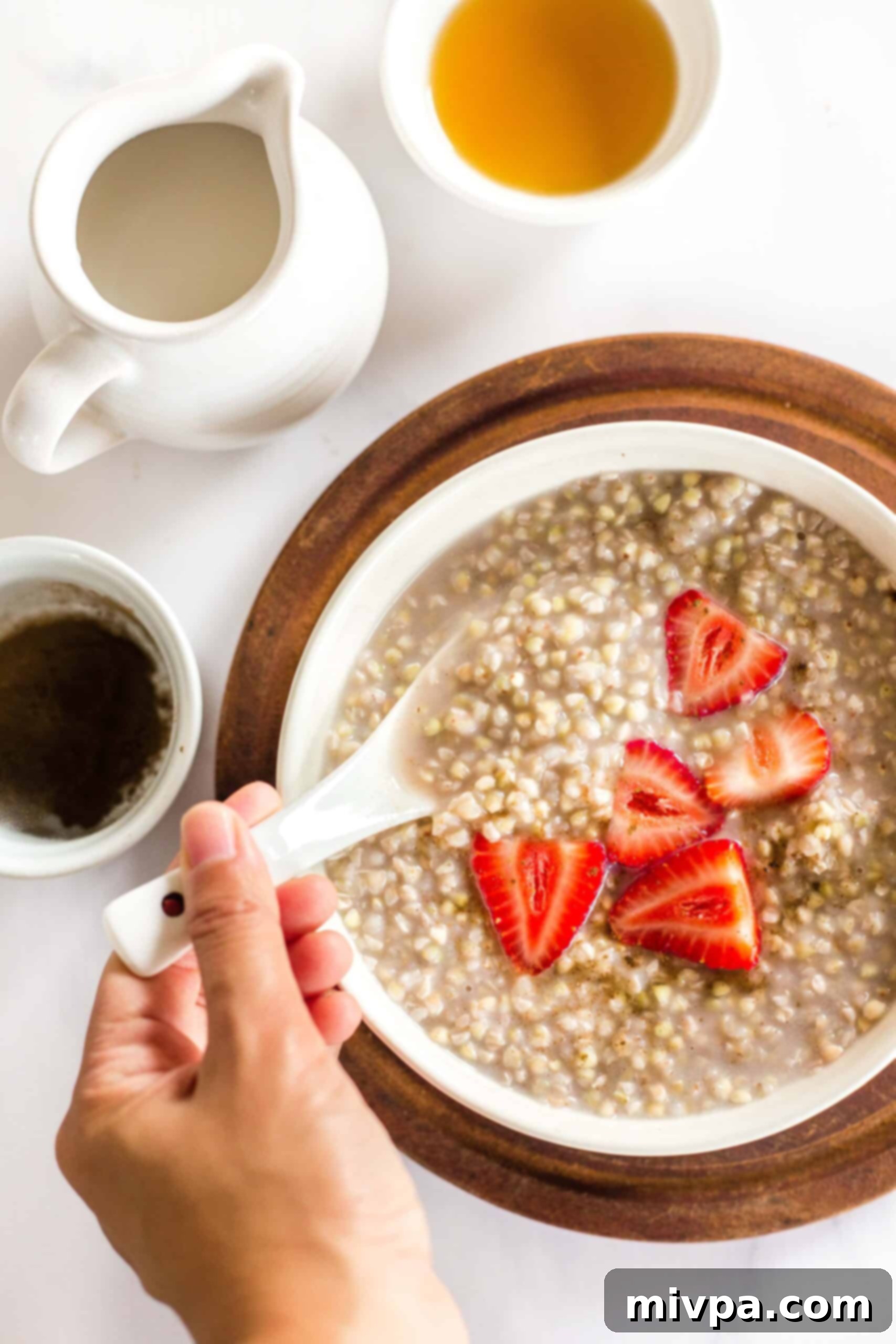
Other Buckwheat Recipes You’ll Love:
- 5-Minute Homemade Buckwheat Flour (Gluten-Free, Vegan)
- Soft, Fluffy Buckwheat Bread (Gluten-Free, Dairy-Free)
- Buckwheat Cookies (Gluten-Free, Dairy-Free)
- Easy Buckwheat Crepes (Gluten-Free, Dairy-Free)
More Delicious Gluten-Free Breakfast Recipes:
- Gluten-Free Chocolate Chip Pumpkin Bread (Dairy-Free)
- 25 Easy Gluten-Free Muffin Recipes for Anytime
- Gluten-Free Pumpkin Chocolate Chip Muffins (Dairy-Free)
- Savory Sweet Potato Toast (Gluten-Free, Dairy-Free)
P.S. If you try this recipe, I’d love for you to leave a star rating below, and/or a review in the comment section further down the page. I always appreciate your feedback. Be sure to check out my entire Recipe Index for all the recipes on the blog. You can also follow me on Pinterest, Facebook or Instagram! Sign up for my Email List to get fresh recipes in your inbox each week!
Print
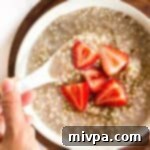
Easy Buckwheat Porridge (Gluten-Free, Vegan)
5 Stars 4 Stars 3 Stars 2 Stars 1 Star
5 from 1 review
Author: Felicia Lim
Total Time: 15 minutes
Yield: 2 servings
Diet: Gluten Free
Description
Creamy, hearty and a perfect alternative to regular oatmeal, this easy buckwheat porridge is completely gluten-free, dairy-free, and vegan. Ready in under 15 minutes, this lightly sweetened healthy porridge is perfect for breakfast or an anytime snack! I recommending topping it with fresh fruit, a drizzle of maple syrup and a sprinkle of cinnamon.
Ingredients
Units
Scale
- 1/2 cup hulled buckwheat groats
- 1 1/2 cups filtered water
- 1/2 cup unsweetened almond milk
- 2 tablespoons maple syrup
- 1/2 teaspoon ground cinnamon
- Fresh fruit, for topping (optional)
Instructions
- Combine Buckwheat Groats and Water: In a small pot or saucepan, combine the uncooked buckwheat groats and water and bring it to a boil.
- Reduce Heat and Simmer: Once boiling, reduce the heat to low and cover the pot with a lid, letting the ingredients simmer for the next 10 to 12 minutes, mixing occasionally until you get the consistency of oatmeal.
- Serve and Enjoy: Divide the buckwheat porridge between two bowls, add a splash of milk to each, top with fresh fruit, a drizzle of maple syrup and a sprinkle with cinnamon.
Notes
Buckwheat Groats: Buckwheat groats are the hulled seeds of the buckwheat plant, and since this is a recipe for buckwheat porridge, it’s important that you use buckwheat groats.
Filtered Water: I use filtered water, but you may also use mineral water or potable tap water instead.
Almond Milk: I like using an unsweetened version of my 5-minute homemade almond milk, but you may also use other non-dairy milks such as cashew milk, rice milk, soy milk, coconut milk or sunflower seed milk if you prefer. Alternatively, if you are not lactose-intolerant, feel free to use normal dairy milk instead.
Maple Syrup: Maple syrup is used for sweetening the buckwheat porridge ever so slightly. You may also use agave nectar if you prefer. Alternatively, if you are not vegan, you may also use honey if you like.
Cinnamon: I like adding a pinch of ground cinnamon for extra flavor, but feel free to leave it out if you’re not a fan.
Storing: To store, place the cooled buckwheat porridge in an airtight container and store for up to 2 days. Reheat in a small pot or microwave before serving.
Make a Savory Porridge: If you prefer a savory porridge instead, simply leave out the maple syrup and cinnamon and add gluten-free tamari soy, sesame oil, a pinch of salt and pepper and garnish with chopped spring onions.
- Prep Time: 3 mins
- Cook Time: 12 mins
- Category: Breakfast
- Method: Stovetop
- Cuisine: American
